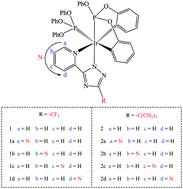Shedding light on the photophysical properties of iridium(iii) complexes with a dicyclometalated phosphate ligand via N-substitution from a theoretical viewpoint†
Abstract
The geometrical structures and phosphorescence efficiency of two series of iridium(III) complexes with wide-range color tuning have been focused on in this work. A DFT/TDDFT (density functional theory/time-dependent density functional theory) investigation on the electronic structure in the ground and lowest triplet excited states, the frontier molecular orbitals, the absorption spectra, and phosphorescence properties of 1–1d and 2–2d has been performed to get a better understanding of the relationship between the structure and property. Importantly, the nature of the N-substituents can influence the electron density distributions of frontier molecular orbitals and their energies, resulting in a change in transition character and emission color, while the attached –CF3 or –C(CH3)3 group on the triazole moiety has an impact on the radiative decay constants of all the complexes. The higher quantum yields of 1a, 1c, 2a, and 2c compared to 1b, 1d, 2b, and 2d can be explained by their larger separation between 3MLCT/π → π* and 3MC d–d states, and the designed 1a and 2a with high quantum efficiency are considered to be potential candidates for deep blue and blue-emitting materials, respectively.



 Please wait while we load your content...
Please wait while we load your content...